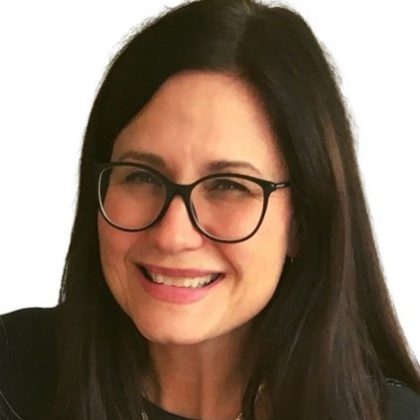Decolonising creative therapies education
Perspectives
Perspectives is dedicated to sharing the knowledge and viewpoints of those with a unique or specialist understanding of art therapy.
In this interview, Dr Michelle Moss, art therapist and discipline head for creative therapies at Charles Darwin University, Australia shares the journey that led to facilitating culturally relevant educational experiences and supporting communities and students to reclaim their knowledge from colonial power structures.
 Could you start by telling us about the journey that brought you to this work?
Could you start by telling us about the journey that brought you to this work?
It’s been a long journey. After leaving school, I enrolled in a Visual Communication Design course at Sydney College of The Arts where I studied a range of subjects that built upon my expertise in the arts. I was particularly interested in photography, this was before digital photography. Having the skill to handprint photographs professionally afforded me the opportunity to travel widely and work. You do not need to speak the language to work in a dark room. I traveled and worked like this for about a decade.
I’ve always been interested in culture and travel and there was one pivotal moment when I was travelling in Morocco. We were somewhere in the middle of the Fez, Medina and a student who was studying English asked if we were lost and took us back to his home. It was a very modest dwelling; a room to the right-hand side converted into a bedroom by night, in an adjacent room, a big table occupied the space and everyone would sit around it doing various activities. I joined the women sitting around the table cleaning the couscous grain before the cooking began. The kitchen was literally a single Bunsen burner with pots layered on it. It was here that the mum made these amazing meals and taught me how to make couscous the traditional way.
This visit was one of those truly culturally immersive experiences that live on with you. As a photographer, I really wanted to capture the moment. I asked if I could take a photograph of them, and the mum reacted in horror and explained via her son that she believed I was going to take her spirit away by taking the photo. That experience really had an impact on me, and I put my camera down for a long time.
When I got back to Sydney, I enrolled in an arts degree and studied sociology, social anthropology, cultural studies, women’s studies, philosophy, and art. I was exposed to thinkers like Foucault (who spoke to power and culture) and that provided me with a language to understand and unpack what happened in Morocco. It’s a language I’ve carried with me and provides the foundations of the teaching I do now. For me, Foucault still has currency as he spoke to power and knowledge which provides a way of deconstructing colonisation and neoliberalism.
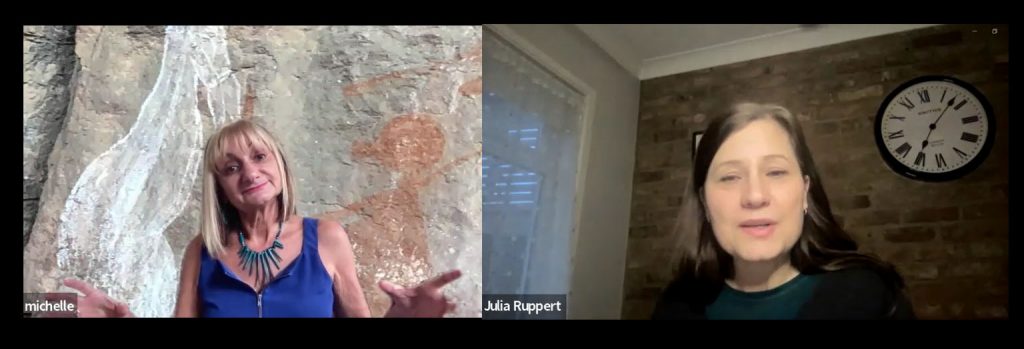
How has being on the ‘other side of the fence’, and not understanding the language or culture play forward in the work you’ve done?
Looking retrospectively kind of brings up those parallels. My studies especially in sociology, provided the language for critical thinking and unpacking the systems surrounding that kind of in-depth experience. I think we all have pivotal moments in our lives, but it is what we do with them that can make the difference.
How did your journey continue?
In my third year of university, someone gave me a pamphlet for a talk John Henzell was giving about art therapy. I had never heard of art therapy, but after attending this talk, I was hooked.
After my Honours year, I applied to do the newly created Master of Arts Therapy at the University of Western Sydney. My final placement was in a child sexual assault counselling service, and it was here that I learned so much from the children (several of the children I saw were also First Nations children). Being open to this learning has had a profound influence on my practice with many strategies devised by the children still in use.
Later, moving to Queensland, I worked for a domestic violence service which was the only service that included children in their remit for many miles around. I was the only child/family therapist and an outreach worker – hence my caseload and waiting list were huge.
Many of the children attending the service were in the child protection system. One family I was seeing had a tragic history and at one point the mother came in asking for me. As I was on outreach, my co-worker saw her. What happened next highlights the system’s failure.
The mother was sent by my co-worker to a mental health service who dismissed her concerns and sent her home. The mother committed suicide that night. This of course had a profound effect on me and was pivotal to my decision to move into child protection.
In child protection, I worked in several positions from intake, caseworker, team leader and acting manager. There was a very innovative man heading the region, and I took a new position he created called the Reconnect Officer. There was recognition at this stage that many of the First Nations children (who made up most of the kids in care) were disconnected from family and country. My role was to devise and identify systems that would help reconnect these children. This entailed a detailed audit, devising a culturally based education program for child protection workers, and working with my First Nations colleagues to unpack ‘what was happening on the ground’ for these children.
At the same time, the innovation in the region continued with an agreement between James Cook University and the regional child protection centre. I was one of five people to be supported in completing a PhD with a focus on child protection. I started off looking at life story books but after consulting with my First Nations colleagues, I soon realised that the concept of life story work and its linear approach did not fit their cultures. This is where I began to look at identity issues for First Nations children in foster care. Part of this research was arts-based and Tony Duwun Lee, a Larrakia Elder, artist, healer and co-creator of the ‘Turn ‘em around Healing’ model also provided analysis from a First Nations perspective.
It was at this point that the work culture within child protection greatly worsened, and I was offered a secondment to work with an Aboriginal and Torres Strait Islander child protection service.
It was this depth of experience as a researcher, art therapist working in trauma and child protection, and worker in the NGO sector that lent itself to a unique perspective that helped me identify the systemic issues that impede good outcomes for our First Nations children in foster care.
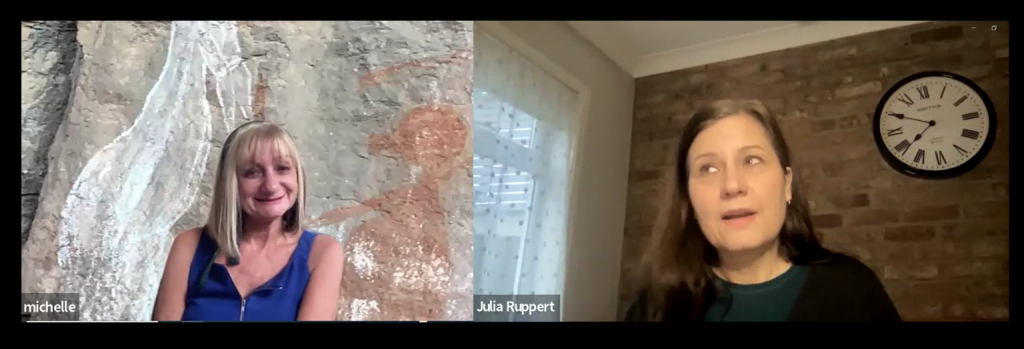
How does your work with First Nations people enable learning to happen in an ‘authentic space’, honouring how the person experiences, tells, and understands their story?
Authenticity, integrity, and social justice are concepts Tony and I have really tried to embed in the creative therapies courses at Charles Darwin University. We took the profound lessons we learned throughout our time working in remote communities.
There is a concept called Dadirri which comes from the Daly River region in the Northern Territory and means deep listening. Dadirri allowed us to really hear and learn from each other. We had to ask, ‘how can we together come up with a new way of seeing and doing?”. It was important to take ‘the expert’ hat off. Being in this context led to continually questioning my own practice and theory bases.
It is these learnings that we embed into the creative therapies courses which can be a difficult space for a lot of students and practitioners. Working in this cultural context demands questioning your practice and biases and that’s an uncomfortable place. You’re having to continually ask yourself, ‘What does this mean for me? And what does this mean for my practice? And what does this say about my past practice?’ I’ve had students that speak of transformative moments where it’s like, “Oh, my God, I had no idea I was doing that!” But that comes from a place of vulnerability and needing to explore and be open to truth-telling.
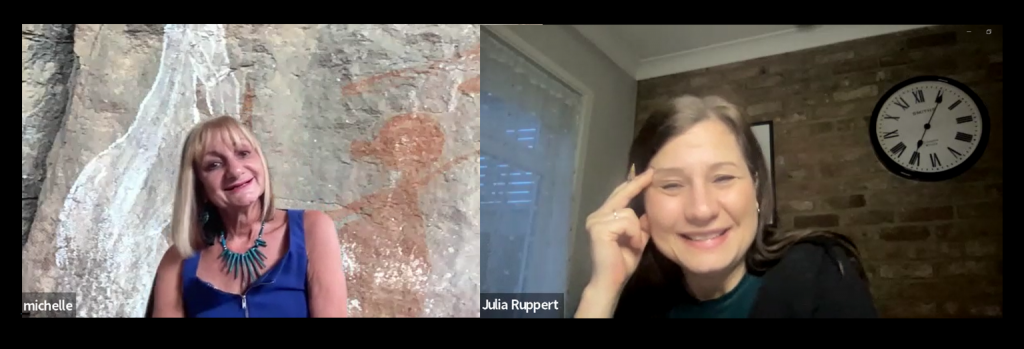
How did the creative therapies courses you developed with Tony Lee unfold?
Unlike a lot of university courses, it came out of our own practice. Back in 2008, there were a lot of reports about sexual abuse in Aboriginal communities. There was also a report commissioned by the government of the Northern Territory, Australia, called The Little Children are Sacred Report which made 97 recommendations. The report highlighted that there were no therapeutic services in remote communities. The system is very skewed towards psychologists and psychiatrists and the use of cognitive behavioural therapy (CBT) which doesn’t work when working with intergenerational trauma with First Nations people.
Because of the remoteness and the difficulty in finding practitioners who want to work in a remote community, the system used, ‘fly-in, fly-out out workers’, that transport the Western model of an hour session of usually CBT and/or medication. If things get bad enough, people are pulled into a hospital-based mental health facility. But this completely goes against any healing practice for First Nations people, because for them ‘being on country’ is healing. To be surrounded by concrete walls and not having family around can feel like a prison.
So, we were tasked to come up with a model of practice that would work for remotely based First Nations people, and I managed that service. The federal government wanted us to visit 90 communities every three months which is ridiculous. I don’t think they had any idea how far away these communities were from each other. We also had a practice reference group with senior practitioners from all over Australia and forums where we would start unpacking what was working and what was not working.
The model was based on continual community engagement and the program was internally and externally evaluated. It was deemed highly successful and was given 10 years of funding, which is very unusual, as funding is usually governed by the three-year electoral cycle. Not long after the funding came through the service was shut down and funds reallocated into child protection.
Tony and I got a little bit of funding to establish a further evidence base for the ‘Turn ‘em around Healing’ model to run small projects in certain communities and some of the published articles below came out of that work.
Part of what we want to do is find ways for First Nations people to ‘upskill’ in healing practice, so they can start healing from within the community. And, rather than adopting a ‘Western saviour mentality’, introduce more of a grassroots model. Aboriginal communities know about healing, but we also offer an injection of ‘deconstructed Western knowledge’ to help with resilience. We also offer a range of educational opportunities on Trauma, Foetal Alcohol Spectrum Disorder and creative healing practices to help build understanding and capacity.
What we found when visiting remote communities was that a lot of health workers and teachers couldn’t recognise trauma, or vicarious trauma and there were so many traumatised workers in communities. We did a lot of education with communities and after consultations with elders, yarning sessions with men, women, health services, and the schools, each community would come up with what they needed in terms of education and healing sessions.
It was from this model and the research underpinning it that we sought to embed the frameworks and philosophies into a decolonised creative therapies course. We also use the Aboriginal 8 Ways of Learning as our pedagogical approach. The course is the first of its kind in Australia and students enrol from all over Australia.
Ultimately, we would like to see more remotely based workers doing the creative therapies course to build healing capacity in communities rather than relying on a system that is spasmodic at best and non-existent at worse.
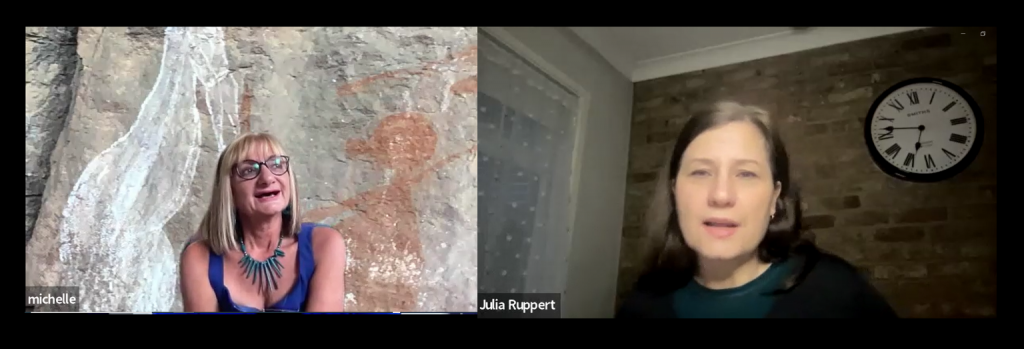
What else drives you to focus your skills in this area?
Having worked so closely with First Nations people in their communities, I am passionate about social justice and equity. I think decolonising the systems we live and work in will have a positive impact on First Nations’ health and education outcomes, which are and have been abysmal for a very long time. I believe the decolonising model of education and practice is transferable and recently published an article that discussed how this model is transferable to social work education.
It is vital for First Nations healing to ensure truth-telling occurs, and that First Nations people have a voice with the hope that this kind of transformative learning can create change on a micro and macro level.
Australia will be voting this year on a ‘Voice to Parliament’ which would alter the Constitution to recognise the First Peoples of Australia by establishing an Aboriginal and Torres Strait Islander Voice. It has also been 10 years since the National Apology to the Stolen Generation. The social determinants of health for First Nations people have worsened despite all the extra spending.
At present, the Australian, New Zealand and Asian Creative Arts Therapies Association (ANZACATA) is working to ensure recognition into systems like the national disability insurance scheme. The mental health system is very geared towards the biomedical model in what it funds.
There is a thirst for a greater understanding of First Nations knowledge and issues. I think the growth of art therapy lies in its own truth-telling and working to decolonise the systems that entrench it.
Michelle’s articles
- On the other side of the rabbit proof fence: decolonizing social work education – a framework for change, Moss, M., Roslyn R & Lee, A. D. Social Work Education
- Turn “em around good way”: TeaH a therapeutic model for working with traumatised children from Indigenous Communities.” Moss, M., & Lee, A. D. (2017). Journal of Australian Indigenous Issues
- Turn ‘em around Healing: A therapeutic model for working with traumatised children on Aboriginal communities. Children Australia
- From Practice to Pedagogy: How Lessons Learned in the Field Helped Decolonize Creative Therapies Education Moss, M, Rowen. R & Lee T. Canadian Journal of Art Therapy
You may also be interested in
- Creating ‘art-alongside’ in Peer Art Therapy (PATh) groups by Mahlie Jewell and Catherine Camden-Pratt in the International Journal of Art Therapy.
Members of the British Association of Art Therapists have full free access to all articles in the International Journal of Art Therapy and Canadian Journal of Art Therapy via the memberzone.
